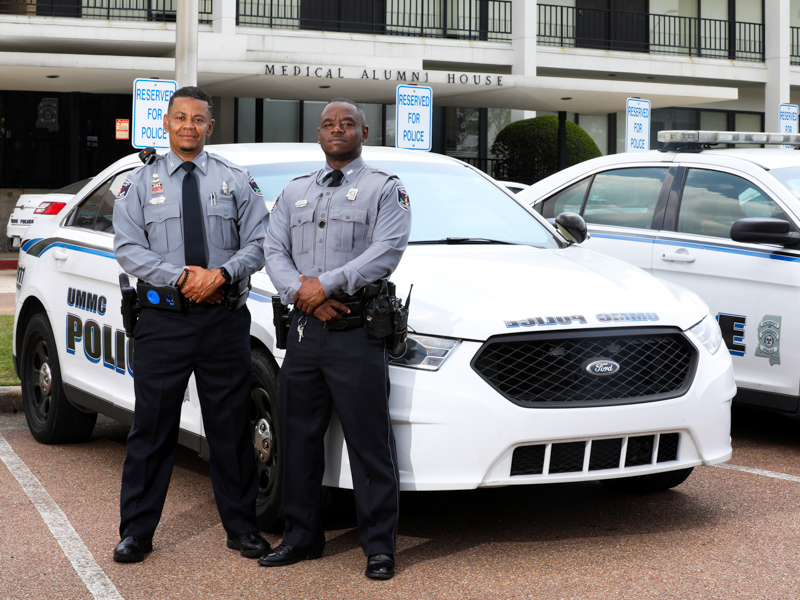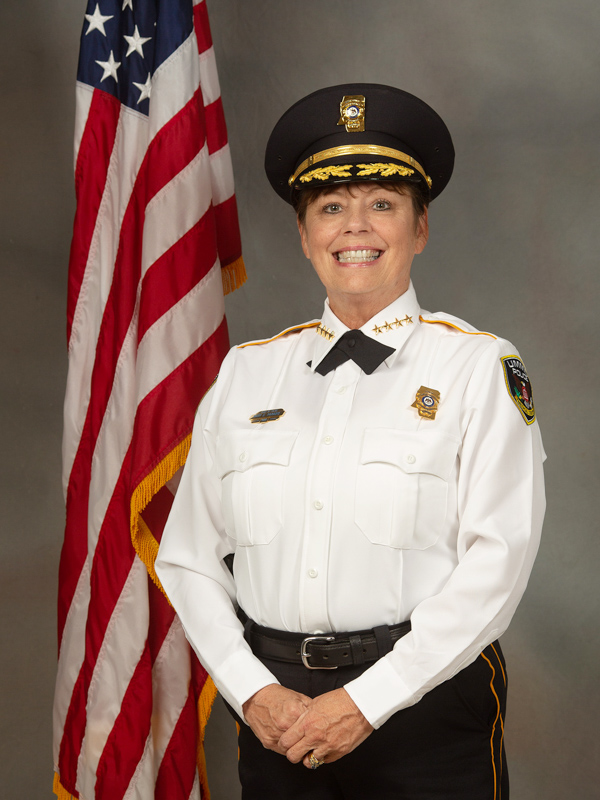Officers picked for pilot behavioral intervention program named Top Cops

Police officers Shaun Hiley and Garry Lee didn’t know it at the time, but the career detours, relocations, chance encounters, and even deployments they’ve endured during a combined 30-plus years in law enforcement were preparing them for a calling for which they both are uniquely qualified.
Tapped in February to lead the police department’s piloted behavior response team, Hiley and Lee responded to rapid response emergencies at the hospital, intervening before conflicts escalated. During the 30-day pilot, in which they worked closely with thedepartments of Risk Management, Patient Experience and the Office of Well-Being, they responded to more than 100 calls.
Chief of Police Mary Paradis was so impressed with their work that she named them both Top Cops. The Mississippi Center for Police and Sheriffs will present them with awards Tuesday, during Police Memorial Week.

“Officers Hiley and Lee volunteered for the program and did an outstanding job deescalating events throughout the campus during the pilot program,” said Paradis. “Their skills were useful at proactively interjecting into situations that could have escalated to violence, resulting in physical harm to our clinical staff and students.”
Hospital administration also took notice and would like to see the team return as a full-time unit, with Hiley and Lee stationed inside the hospital for easier accessibility.

“We hope to have the BRT operational soon,” said Chief Administrative Officer Dr. Jonathan Wilson.
That the two were selected for the pilot was no random assignment, said Deputy Chief Joshua Bromen.
“The BRT unit requires a unique officer who has strong emotional intelligence and situational awareness,” said Bromen. “Officers Hiley and Lee have demonstrated over their careers empathy, strength, and a level of compassion and care second to none.”
Hiley, who is filling in as a power sergeant, believes this honor is confirmation that he rejoined the force at the right time. He became a certified police officer at UMMC 30 years ago. After a year of itching to apply his training in “street life” scenarios, the Chicago native joined the Pearl Police Department, returned to UMMC for a few years, and left again for stints on a narcotics task force in Greenwood, as a canine officer at Jackson-Medgar Evers Airport, a probation and parole officer, and an investigator for Jackson Public Schools, where he received his first Top Cop Award for closing the most sexual assault cases three years ago.
The Ridgeland resident said he has loved and received invaluable training at every job he’s held, only leaving each when he felt it was time for something new. He started his third tenure at UMMC in January, a month before being asked to work on the BRT.
His 28 years of diverse experience in law enforcement, coupled with crisis intervention training from Hinds Behavioral Health, helped prepare him for his new role.
“The BRT bridges the gap between the hospital, disgruntled patients, and clinical staff,” said Hiley, a father of three. “With so much focus on negativity with law enforcement, it feels good to be recognized for something positive.”
Lee, a patrol officer of eight years, joined the Air Force after high school and deployed twice to Kuwait. Though he wanted to train for Special Forces, he chose not to because of the time he’d be away from his two children, deciding instead to become a civil engineer, and later a firefighter. After leaving active duty (he has been in the National Guard 18 years), Lee channeled his interest in law enforcement into taking a job as a probation officer in Rankin County before becoming a police officer.
“I started with probation and parole because you have so much one-on-one interaction with people,” said Lee, of Clinton. “Being a Black male and seeing my community suffer, I wanted to help some way.”
After working as a patrol officer for eight years, being hand-picked for the BRT was refreshing.
“I felt honored to be chosen when I learned what it entailed because I felt appreciated for the work I’d done,” said Lee. “Being on the BRT, I felt more in tune with patients and staff, just really getting that one-on-one time to sit down and try to learn the causes of frustration and come up with ways to fix it.”
During the pilot, the unit received seven to 10 calls a day. The volume shot up after the pilot ended.
“Most of our focus when we first started were the adult psychiatric floors and the pediatric behavioral floor,” said Hiley. “We would go daily and ask nursing staff which patients were at an escalated state. We would then have a conversation with those patients because sometimes people just want to talk. Other times, we would get calls because patients were lashing out toward nurses.”
Hiley and Lee, in plain clothes, would calmly ask probing questions to determine the source of frustration, letting patients know they were concerned for the safety of both the patient and the staff. “Some of them were just having a bad day and wanted someone to listen,” said Hiley.
At the end of each shift, the two submitted reports to police administration, clinical risk management and patient experience, in which they addressed problem areas.
“At the end of the day, you feel good because you know you’ve made a positive change,” said Hiley.
Said Lee: “I knew that when I left out of a patient’s room, I would receive calls throughout the day, from those same patients wanting to talk, because we were building relationships.”
The BRT concept has been used by other organizations for years, so it was clear that UMMC would benefit from its best practices, said Elizabeth Toony, former director of clinical risk management. Because the success of the program is based on the prevention of events, there is no way of knowing how many potentially violent incidents might have occurred without the BRT’s intervention.
“This will be a game changer for the organization,” said Toony. “The pilot was a great success in large part due to the two officers who responded to the calls. Hiley and Lee were committed to de-escalating events and became a calming force.”


